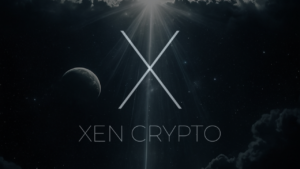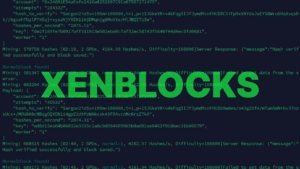XEN Crypto is a multi-chain token. XEN is on 9 blockchains such as Ethereum, Ethereum PoW, Polygon, BSC, Avalanche, Moonbeam, Evmos, Fantom, and Dogechain, and more chain integration is coming. Our community members are everywhere now, but to be there they had to cross bridges between chains, do cross-chain swaps, and find token prices and exchanges. That wasn’t always easy because the blockchain space is fragmented, so here we are to guide you on this crypto journey.
Disclaimer: we provide links and information about the available tools, but we can’t guarantee their security. We take no responsibility for any funds lost or security issues resulting from your use of these tools.
Centralized vs Decentralized
The blockchain was created with certain principles in mind. It was created to eliminate counterparty risk, meaning that it’s based on P2P transactions and there are no middlemen. It brought concepts like self-custody, where the holders of a coin or token have exclusive ownership of their funds by owning and securing their private key to the account. Blockchain accounts are different from traditional banking or brokerage accounts where different institutions have access to users’ accounts. There are centralized cryptocurrency exchanges (CEXes) which facilitate the onboarding of new users by exchanging fiat currency (USD, EUR, YEN, etc.) to cryptocurrencies. However, they also constitute a counterparty risk because when you create an account with them, they have access to your account and can freeze it whenever they want to.
For those users who care about self-sovereignty, there are decentralized exchanges (DEXes) where users exchange cryptocurrency while owning their keys. Everything a user does on a blockchain is transparent and verifiable on-chain via different chain explorers. There are different wallets like MetaMask, Keplr, and others to create accounts on a blockchain and interact with applications (smart contracts). The blockchain space is still very fragmented. There are many different networks, where the most common are Bitcoin, Ethereum, BSC, Polygon, Polkadot, Cosmos, etc., and each of these networks has different tokens and coins native exclusively to that particular network. It’s not possible to simply move 1 ETH from the Ethereum chain to Polkadot and use it there. It needs to be swapped and to cross a bridge connecting Ethereum and Polkadot. Here we describe what these swaps are, where to do them, what bridges are and how to cross them, and how to view transactions on-chain so you can track your whole journey. We explain how to use the 7 chains where the XEN Crypto smart contract has been set up so that Xenians can trade their XEN that is tied to a specific chain.
What are swaps
“Swap” means exchanging one cryptocurrency for the equivalent value of another cryptocurrency on a particular chain. The most popular place to perform a swap is directly in your MetaMask wallet. Metamask combines data from different sources to give you the best price with the lowest network fees. They charge a service fee of 0.875%, which is automatically factored into each quote. Users can set the maximum slippage, which is the change of the exchange rate between your placed order and its execution. The slippage can be high when the liquidity is very low or where large swaps are being executed. This can cause a high cost for a swap. When swapping with MetaMask, orders are spread across virtually all DEXs to reduce the impact of slippage on the final price.
Swaps can be done on DEXes like Uniswap, Curve, 1inch, Sushi and many others. When you do swaps on Uniswap, you only need to connect your wallet, select a token you want to swap for anything else, set the amount, and confirm the transaction. A similar process is used for other DEXes. It needs to be added that in swaps, the opposite party to your swap is the other trader and an AMM (Automated Market Maker) pool with two tokens, making the pair a user wants to exchange.
What are Cross-Chain swaps
Cross-chain swaps are yet another thing. While swaps are made between two tokens on the same network, like, for example, Ethereum, cross-chain swaps are made between tokens on two different chains, like, for example, Ethereum and BSC. They involve liquidity pools composed of two or more tokens from multiple chains, rather than on the same chain. There’s still a risk associated with price slippage. For a cross-chain swap, you need to use another kind of tool, like for example Multichain.
What are Bridges
Bridges are a different kind of animal because they don’t rely on AMMs and don’t bear the risk of slippage. There’s only a service fee to pay. The bridging mechanism involves one kind of token and mint and burn functions. In a bridge, there are only two wallets connected on two sides of two networks. When a transfer is made, a user burns a certain amount of token X on the smart contract of blockchain X, and then the smart contract of the target blockchain Y mints the corresponding number of token X and transfers it to the user’s address.
How to mint XEN on different chains
XEN lives on 7 different chains so far. It has a different ticker name on each chain:
- XEN on Ethereum
- vvXEN on ethereum PoW
- bXEN on BSC
- mXEN on Polygon
- aXEN on Avalanche
- coXEN on Evmos
- mbXEN on Moonbeam
- fmXEN on Fantom
- dcXEN on Dogechain
If you want to mint XEN on any of these chains, then the first step is always to get some crypto first. You can buy ETH directly from MetaMask or you can use any centralized exchange like Kraken, Binance, Coinbase, or other kinds of apps. If you’re a privacy-focused person, then you can buy Bitcoin on a DEX like Bisq or Hodl Hodl or at a Bitcoin meetup and swap it for ETH. Once you have ETH, you can mint XEN on Ethereum by connecting your MetaMask to xen.network.
If a user wants to mint XEN on some other chain than Ethereum, then there’s a need to get a native token on that chain first. Let’s say that we want to mint XEN on Avalanche and you have USDC on Ethereum. You need to swap USDC for ETH first, and the simplest way is to do this with your MetaMask, or you can use Uniswap or Sushi. Then you need to transfer this ETH to the Avalanche chain and swap it for AVAX because AVAX is needed to pay for your transactions on that chain. So you can do a cross-chain swap with something like RocketX or Rango and exchange your ETH for AVAX. Once you have AVAX, you can connect to xen.network and mint your XEN. The XEN dapp is your interface where you can find addresses of the XEN Crypto smart contracts on every chain and where you can connect your wallet to each of these newtorks and mint XEN.
Or you could just use one of these tools to swap USDC directly for AVAX in one user interface.
You can use these tools for swapping tokens between chains and minting XEN on different networks.
If you want to mint XEN on BSC, then you can use the Secret Network bridge, which will keep your transaction private. You need two wallets for that and some SCRT tokens to pay for the bridging fees:You hold on tor ETH on Ethereum and a Kplr wallet for bridging your assets to the BSC chain, where the native currency is BNB. Once you cross the Secret Bridge, your BNB will have no record of transactions you made on Ethereum, and you will be able to mint XEN with that BNB on the BSC chain.
How to mint XEN on Dogechain
We’ve seen that many people find it difficult to mint XEN on Dogechain because of the difficulty in getting there without passing through a CEX. We describe in detail how to mint cdXEN. To pay the fees, you must first obtain wDOGE on Dogechain.
DEX Route:
Go to xen.network and connect your MetaMask. Your wallet should prompt you with the Dogechain network addition. If this won’t happen, go to chainlist.org and click “add to MetaMask” in the DogeChain option.
Now you go to the Dogechain bridge to choose the address on the target network. You need this address to receive your DogeCoin. Press ‘Reveal address’ and copy it.
Visit Changenow.io and swap ETH for DOGE. You need a minimum of 100 DOGE to use the bridge. Press ‘Exchange’. Paste in the ‘Recipient address’ you previously got from the bridge page. The bridge will give you wDOGE on Dogechain, and you’ll be able to view it in your MetaMask.
CEX Route:
Add Dogechain to your MetaMask (see above). Buy DOGE on a centralized exchange, and then go to the bridge (see above) to get wDOGE on Dogechain.
Once you have wDOGE, you can connect your MetaMask to xen.network and mint your XEN.
How to buy and sell XEN on different chains
XEN has very low liquidity now and trading it may expose you to slippage. Most trading occurs on centralized exchanges, but on DEXes, people can trade XEN while holding the keys to their wallets for the whole time. It’s difficult to find places to trade XEN on the chain. The most common place is Uniswap, but we list here the most popular DEXes specific to each chain where you’ll be able to trade XEN paired with different tokens:
- Ethereum XEN – Uniswap
- BSC bXEN – Uniswap, Poocoin
- Polygon mXEN – Uniswap, Quick Swap
- Avalanche aXEN – Trader Joe
- Ethereum PoW vvXEN – Uniswap, PoWSwap
- Moonbeam mbXEN – Beam Swap
- Evmos XEN coXEN – Diffusion
- Fantom fmXEN – Bogged Finance
- Dogechain dcXEN – KibbleSwap
All these DEXes have very low depth in their liquidity pools, and some disappear as soon as they dry out. When you want to trade your XEN, it’s best to go to an aggregator website like DEXscreener, paste the contract address of the XEN token you want to trade, and check available token pairs for each kind of XEN and exchanges where it can be traded. By pasting the contract address in the search field, you make sure that you find the token pairs for that exact token and not some other token named the same way.
At this early stage of the project, it’s unlikely you’re going to make a cross-chain swap, so if you want to sell your mbXEN on Moonbeam and move the funds to Ethereum, you’ll need to swap mbXEN on Moonbeam for some other token like ETH, DAI, or USDT, for example, and only then you’ll be able to bridge it to Ethereum.
What’s the price of XEN tokens
When you want to check the price of XEN, you need to go to nomics, coinmarketcap, or to some exchange where XEN is listed. If you want to check the price of other XEN tokens, things start to get complicated because of the low liquidity.
Here’s the list of places where you can check the prices:
Ethereum XEN: CoinGeko, Coinmarketcap, Nomics
BSC bXEN: Coinmarketcap, Dexscreener
Polygon mXEN: Coinmarketcap, Dexscreener
Avalanche aXEN: Coinmarketcap, Dexscreener
Ethereum PoW vvXEN: Dexscreener
Moonbeam mbXEN: Dexscreener
Evmos coXEN: Dexscreener
Fantom fmXEN: Dexscreener
Dogechain: Dexscreener
List of centralized exchanges where you can trade XEN:
BingX, Gate.io, MEXC Global, Huobi Global, Poloniex
How to view XEN transactions
To view blockchain transactions, you need to use a chain explorer, and every blockchain comes with its own. Below, you can find network-specific scanners to explore on-chain transactions:
Ethereum – Etherscan
BSC – BSC Scan
Polygon – Polygon Scan
Avalanche – Snowtrace
Ethereum PoW – OKlink
Moonbeam – Moonscan
Evmos – Mintscan
Fantom – FTMscan
Dogechain – Explorer.Dogechain
Multichain explorer for cross-chain swaps.









